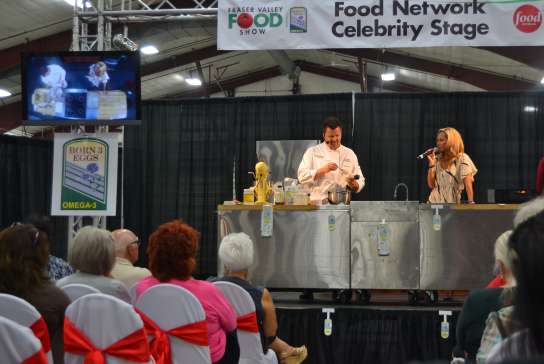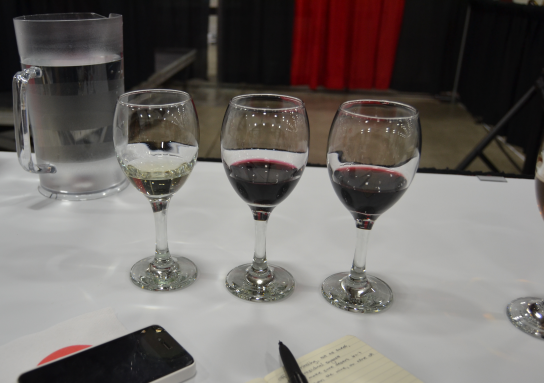By Amy Van Veen and Karen Aney (The Cascade) – Email
Print Edition: September 19, 2012
The foodies showed up in droves at this year’s Fraser Valley Food Show. Last year, the crowds were slim – although I did go on a Friday last year unlike this year’s Sunday outing. Many of the exhibitors came back once again including the garlic grater salesman with his Sham-Wow-esque headset microphone and the BC Cranberry ladies with their mini flooded cranberry “field” and overall waders. The Master Chef competition was back, as well as the Celebrity Stage, although this year’s food show diverted a little off the food and drink path and into home and well-being territory. For example, Sunday afternoon’s celebrity stage demonstration was a woman explaining the different ways to renovate your kitchen and a stone’s throw away from her end of the exhibition floor were massage chairs and electronic massagers; bed sheets and fitness passes; and vacation packages alongside the BC Cancer Agency and anti-drunk-driving stands. The one stand I did miss from last year was Hills Foods from Coquitlam, who advertised their speciality meats such as ostrich and kangaroo. I had hopes of purchasing some strange game to sneak onto the plates of my dinner guests as a fun conversation starter, but alas, this year they weren’t on the list. The main difference, though, was the take-home bag of goodies. Last year’s was filled with brochures, chocolate-covered acai berries and organic rice oil, but this year’s nondescript bags were filled with one soy drink, one almond milk drink and one granola bar. It was a sad little ending that did a disservice to the plethora of stands and foodie options inside.
The wonderful world of cheese
This seminar was presented by trainer/consultant Reg Hendrickson on behalf of the Dairy Farmers of Canada. The audience was given seven cheeses to taste, in order of how “aromatic” they were.
The first cheese was mascarpone. This is an Italian cream cheese. The fact that it’s made from cream—not milk—is what makes it so rich. The tasting was presented on a spoon; the mascarpone was at the front, with some honey behind it and a dried cranberry on top. The audience was directed to first taste the cheese on its own, then with the cranberry, then with the honey. This was done to demonstrate how dramatically the flavour profile of this mild cheese changed depending on what it was paired with – definitely something to try replicating on your own; it was eye-opening.
Next on the list was bocconcini. This is the little white balled cheese served in caprese salad. Hendrickson explained that this is a great choice for pizzas because of the way it’s prepared – it’s what’s known as pasta filata, which means it’s cooked and stretched. This means that when it’s cooked it doesn’t melt into a huge, gooey puddle (though there’s nothing wrong with that) – it will retain its shape through the cooking process, meaning you’ll have lovely chunks of cheese dispersed throughout your slice. Hendrickson also explained that the liquid bocconcini comes in isn’t brine, like with feta, but water. Over time, it becomes murky as the proteins in the cheese break down. Because of this, it’s important to always use clean hands or utensils to get your bocconcini out of the water; if you don’t, you’ll end up with a not-so-lovely slime in your container.
The other cheeses were all great, but the facts Hendrickson presented were more interesting: first, pregnant women should stay away from raw milk cheeses. You can freeze cheese, but only to cook with – if you try to defrost it, the process will break down the proteins. Finally, cheddar is orange because of a flavourless vegetable dye – why? Tradition. It started in “the old days,” Hendrickson says, when livestock was fed different grain in summer and winter which resulted in different hues of milk. Now you know.
Swirl, sniff and sip: the pleasures of tasting wine
Presented by Kathleen Rake, this seminar included three separate wine tastings – a Riesling, a Garnacha, and a Malbec. More importantly, she went through the steps of “how to taste wine” – here’s quick guide so you can impress your friends.
First, look: what is its colour? How pale is it? How deeply yellow/purple/burgundy/etc? Does it have bubbles? Does it have “legs” – meaning, does it leave behind swells of liquid up the walls of the glass after swirling?
Next, smell. Smell for fruits, then vegetation, then minerals. Swirl the wine—look for those legs!—and smell again. Put your nose all the way in the glass, and really take a big whiff. Don’t be afraid to liken its scent to fresh rain on pavement like Rake did!
Finally, taste. Bring the wine into the mouth, then lean forward with it inside your mouth and suck in small bursts of air. The leaning forward keeps you from choking, and the small bursts of air make slurping noises. More importantly, they cause the wine to coat your entire mouth and palate, meaning you can taste the wine with all your different taste buds.
After that, remember that no one slurps wine and proceed to sip—or gulp—the rest of it like a normal person. Or use the spit bucket provided – if you’re the driver.
Gluten free: a major foodie trend
The world of food and drink is much like any other consumer industry in that it is subject to trends and fads. At this past weekend’s Fraser Valley Food Show held at the TRADEX in Abbotsford, it was hard to walk five steps without passing a sign promising gluten-free options. The difficulty in maintaining a gluten-free diet for those with either Celiac’s or a gluten sensitivity is finding products sans the G word. As anyone who follows this strict diet knows, the options are few, the prices are high and the baking is nightmarish since gluten is the very thing that is most often used to preserve and bind ingredients because of its low cost.
Local companies throughout the food show advertised their gluten free friendly options in large print fonts. The Milsean Shoppe located in Aldergrove, BC, promised gluten-free chocolates and candy, as did Xocai Healthy Chocolate. Grimm’s Fine Foods promised gluten-free meat products with Country Prime Meats offering the same alternative a few stalls down. Caramoomel—a family company based out of Kelowna that makes flavoured spreads and wine jellies—is proud of their gluten-free labels. Even Gone Nuts, a candied nut company, jumped on the trend by offering a pecan bar made to these specifications. While the prices reflect that gluten-free options are still considered by many to be a speciality alternative, their increasing prevalence is providing new dining opportunities for those with medical or personal preference of a diet without gluten.





